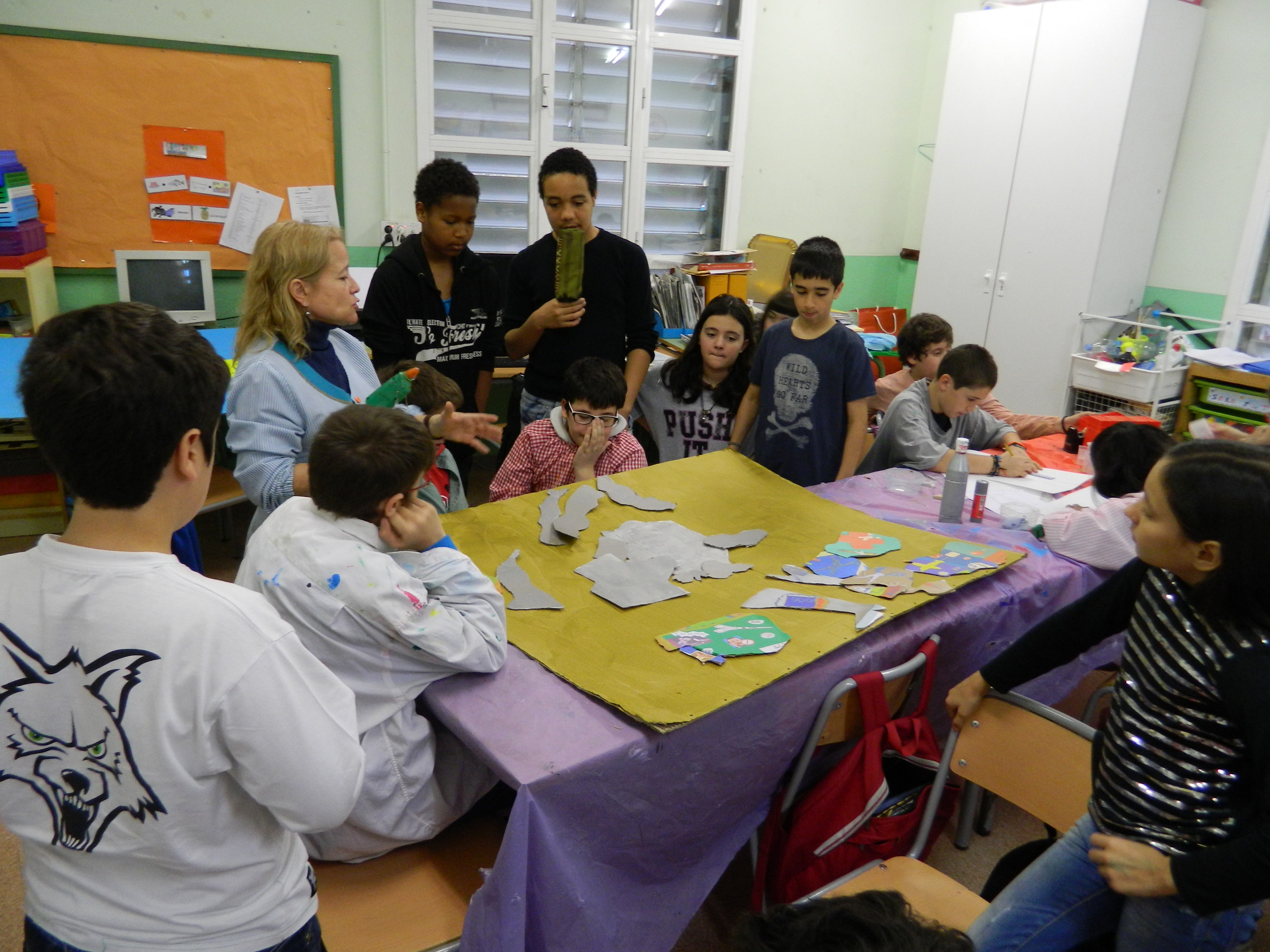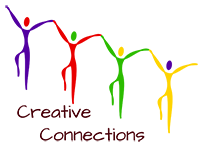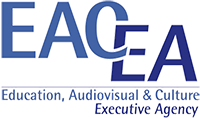Escola Dovella Primary School - Spain
Region: Barcelona
Other schools in the Quad Blog: Utsjokisuun Koulu (Finland), Escola de Vila Praia de Âncora (Portugal), Avenue Primary School (UK)
Creative Connections Project: Local and Global Views

Escola Dovella. Image of Europe Activity. Photo by Carmela Márquez
Context
Dovella primary School is located in the city of Barcelona, capital of the Autonomous Community of Catalonia. The city has 1,620,943 inhabitants, which makes it the second most populated city in Spain, after Madrid and the eleventh largest city in the European Union. The school is located specifically in the neighbourhood El Clot, which like other neighbourhoods of Barcelona not in the city centre, has an industrial past (XIX century), which has determines its architecture and urban planning.
The Dovella School was established in 1972 by a cooperative who were seeking quality public education, which later (after Franco) in 1989, would consolidate in the current public primary school, which belongs to the Generalitat of Catalonia. The school has two age phases: Nursery, children between 3-5 years and primary education from the grades from 1 through 6 for children 5 to 12 years old. The school currently has 225 students. The school is characterises itself by continuing to work in a participatory manner, between teachers, students and parents and seeks educational innovation. Its current pedagogical model is the Inquiry Learning Projects.
Participants
The Creative Connections project was carried by the 6th grade class (24 students) and was led by the Project researcher and a PhD student of the Art and Education programme from the University of Barcelona.
Process
The Creative Connections Project, unlike the secondary school, was not done in the context of a specific subject as both Catalan primary schools participating in the project (Escola Dovella and Escola Serralavella) work with the pedagogical model the Inquiry Learning Projects. With this in mind, Creative Connections was considered as any other learning project and a tool for developing and link with other class projects. The project began in school in January 2013 and continued to June 2013.
In the case of Dovella School, there was not a programmed way of working, but it was made according to the needs of the group, which made them devoted to the work, in some weeks more than the others. The Creative Connections project was considered as any other learning project of the class, and therefore it was necessary to create ongoing links with other activities being carried out simultaneously. Also during the process the teacher was accompanied by the researcher. This helped a lot when it came to sharing with the entire Creative Connections group (of teachers and researchers) the way of working in the school, because the teacher could not attend any of the monthly meetings, due schedule problems.
One of the interests of the school, which made them agree to work on the project, was to establish contact with other European countries and the opportunity to work with contemporary art; an experience that was very successful in a previous work. From a visit to the exhibition ‘Cartografías Contemporáneas’ (Contemporary cartography) from the Caixa Forum, supported them on working on the concept of identity, and the children created their own biographical cartography that they used as a presentation on the Creative Connections web site.
As a first task, they (the class) embarked on answering what Europe meant for them, aiming to reflect on the significance of Europe, for all. Wondering what it means as a concept today. They aimed to contextualise the idea of Europe in a global way and also locally.
‘Being Europe,’ as such a general concept, it was important to build connections and relationships with their own lives. To achieve this it was necessary to move from the external to the internal and vice versa. Wondering how this connects with them. This was done as follows; First they generated a brainstorm: they started naming geographical locations; wondering to what other countries ‘I have travelled’ or would like to travel, ‘What countries conform the continent?’ (for which students revised quickly in a map or a globe) to talk on a more conceptual point of view, wondering about stereotypes and how was it before and how it is today, what problems afflicted the continent (for which many informed themselves by the Internet or a newspaper). All reflection was recorded, and was handed out to all classmates afterwards.
Taking the concepts proposed in the previous reflection (the brainstorm,) students produced, first individually, an image of Europe, considering the conversations made in the first step and trying to go beyond the geographical image. The images were made first as a drawing and secondly as a collage, but after this activity, it was necessary to see how the concepts of Europe connected with their everyday lives.
There was definitely a concept that emerged both in conversations and in the images produced, which was the economic crisis and how the group would like to change this situation. It was then that the whole class decided to reconcile the ideas in two images, which they made collectively. One was a symbolic map of the continent, marking the economic boundaries that showed a Europe in crisis and the other was a big plus sign (+) full of positive concepts of the continent.
When the images of Europe were completed, the next activity was to revisit the Art Database of the website (they had seen the Art Database with the teacher before, but only as an introduction), but this time they devoted two full sessions of two hours. This time, the class tried to generate a conversation about artworks from the Database, trying to go beyond a value judgment of ‘I like it’ or ‘I don’t like it.’ They discussed different media used by artists as the topics that artists were questioning. After these sessions, each student had access to revisit the works on the website to dig deeper about the artist that they were more interested in.
The next step was to produce their own art works, by using or not, these Contemporary artworks as inspiration. Some did this individually and others formed small groups of no more than three people to produce their artworks.
The production process consisted of an initial interview or conversation with each group or individual with the researcher, to solve both the concept behind the work and to solve technical problems, such as the use of materials. Having clarified that and having some preconceived ideas of a future artwork, a second meeting was held with the whole class and the teacher to help each other and generate a series of controversies that were very constructive for the whole group
The next step was the production of the artworks, in which they went from the theory to the practice, which was a challenge, because the group tried that the materials used, were faithful to the intention behind the artwork. For the whole group, this process was therefore a great time of learning and a pursuit of more of a sense of responsibility in the producing of an artwork.
Achievement
Although one of the purposes of work on the project was for the school to connect with the children from other schools in Europe, this did not happen satisfactorily in their blog. However, the production processes of their artworks and the links to Creative Connections Contemporary Art database and other contemporary art exhibition, generated a change in the way that the children understood art, and also allowed them to find a platform to talk about themselves and social issues. The process also meant a form of union of the whole class as they completed their senior year at school.


